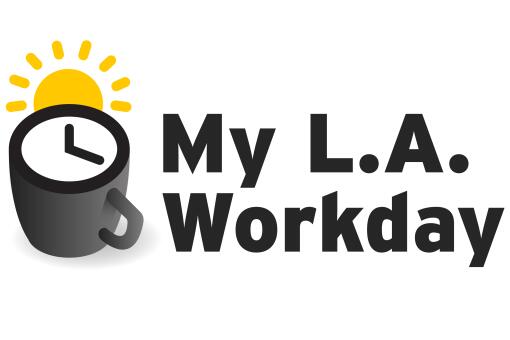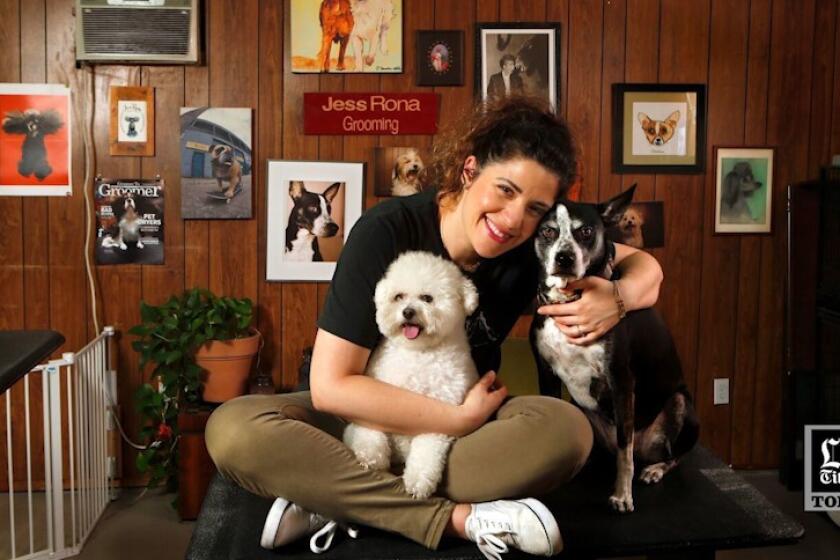
- Share via
Welcome to My L.A. Workday, a series that takes you inside a day on the job with some of the city’s most fascinating people. Interviews are edited for length and clarity.
Forget elaborate coffee orders; when art restorer Henri Laborde needs to wake up in the morning, he’ll take a bracing bodysurf in the churning, ice-cold waves of the Pacific Ocean.
“You get out of [the ocean] and you feel like someone took one of those pressure washers, and just kind of washed you inside. You feel cleansed, you feel energetic,” he says.
He’ll use that energy to sit, sometimes for hours, painstakingly repairing cracked ceramic and shattered porcelain.
BUSINESS
What do you do for work?
That’s the question My L.A. Workday answers. The series takes you inside a day on the job with some of the city’s most fascinating people. Interviews are edited for length and clarity.
Since he landed in Los Angeles in the ’90s from his native France, Laborde has taken repair commissions from art museums, auction houses Christie’s and Sotheby’s and wealthy private clients. He has restored a diverse assortment of pieces, from one of Jeff Koons’ balloon dogs to a dog made of painted and folded cardboard, and including three Fabergé eggs worth $100,000 apiece and a towering 9-foot-tall Batman figure for Warner Bros. Studios.
On a recent summer Friday in his downtown studio, Fine Art Restoration, he worked on a more humble request: six small Santa Claus figurines, many missing portions of their mittens, from a paint-your-own-pottery studio. Each was marked with a handscrawled “Sharon 1970” on the bottom, and together they represented the only part of the client’s mother’s estate she received following a contentious dispute.
He mixed a special concoction of acrylic, plaster and paint to form a paste that will dry softer than the original ceramic. This allows him to sand and mold the missing pieces to the proper form, without damaging the figurines. Avoiding further harm is of the utmost importance when taking on a project — even when it’s a beloved family tchotchke.

Laborde, 48, has made it his mission to restore ceramic and porcelain pieces of both monetary and sentimental value.
He says he treats each object with the same amount of care, regardless of the price point. But “I do get a bigger kick out of the interactions with [sentimental] people,” he admits. “Oftentimes I get a hug too, which doesn’t hurt.”
When you spend many hours a day intensely focused on the smallest details of an object, the breaks are just as important as the work. Here’s how Laborde powers through his workday with bodysurfing, tai chi and strategic fasting.
Van Nuys-based astrologer and witch Gogo Akopyan promises to tell you about your past, present and future. But first: coffee, stirred clockwise, with intention.
7 a.m.: Go for a surf, minus the board.
I get up in the morning, and three to four times a week I go to the gym. Sometimes I bodysurf. I grew up by the Mediterranean Sea, in the south of France. And the sea is just like oil. There’s nothing happening there. It’s boring and it’s warm.
In Venice the ocean is cold, and it’s moving. Once I tried surfing for half an hour. I hated it. I thought maybe I could just kind of swim. I realized that if I put my body like those guys who skydive, I pick up enough momentum.

People look at me often and ask ‘Where’s your board?’ and I go, ‘It’s just my arms. That’s it.’ Bodysurfing just feels amazing. It’s better than any drug, better than any alcohol.
8:30 a.m.: Make the to-do list.
When I get [to the studio], the first thing I do is I sit down and I start checking emails so I make sure I don’t forget anyone. I like to respond to people as quickly as possible because I’m the type of person who doesn’t like to wait when I request something. So I treat my customers the same way.
I set up a plan for the day. And I go, ‘OK, today, my goal is I have this many hours, my goal is to work on this, I absolutely have to finish this piece, then I have to do resin here, and then I have to get in the booth and spray. If I have enough time, I should start working on this project.’ And I try to stick to the plan. It doesn’t always go as planned. But most of the time, I’m able to achieve everything.
10 a.m.: Crank up the sound.
I start working. I put some music on, oftentimes I put on some YouTube videos about health, geopolitics, the economy. When I don’t feel in a great mood for working, I put a movie on. Since I have speakers all around my shop it’s almost like a cathedral. The sound is everywhere. Work almost doesn’t feel like work.
I take on everything. I respect people too much to say, ‘No, I think this is below me.’ (Though someone once brought me a toilet seat, which I refused to touch.) I’m here to help so just bring it on. Oftentimes people are very shy to bring me pieces. I have this unusual ability to fix stuff and I just really want to help everyone who comes through the door.

2 p.m.: Tai chi to get the blood pumping.
[My routine] really varies. That’s what I like about what I do. I’m just on my own energy. I have a nice, large space in my studio so I can practice tai chi, which I studied for eight years in a martial arts academy, along with kung fu.
I want the energy to keep flowing. At the same time, I’m trying not to think about the movement. It’s like a meditative state. You’re engaging your muscles, so you keep the blood pumping at a decent pace. It really gets my rhythm going again.
Breaks are really important because of what I do. You have to be intensely focused on something. So when I take a break, I remove myself from the situation. And when I come back, my eyes are really fresh. All of a sudden I might see that I was [painting] it a little too dark. But, when I was in the zone I just couldn’t really see that. So I remove myself and I come back to it and then I’m able to do a better job.
4:30 p.m.: Meditate on the roof.
I like to go up to the rooftop, because the lights are beautiful. There are lots of plants. I’m meditating in my own little garden and I can sit there for 20-25 minutes. I put some music on in my earphones. I just relax up there and it’s wonderful. I’m big on nature. That’s why it’s hard for me to work here. Downtown is the opposite of nature. It’s concrete, asphalt and steel.
5 p.m.: Break my fast.
I have a snack when I come back from the rooftop — it’s always the same, walnuts and pistachios. I only eat during a four-hour window every day. It’s great because it’s very healthy, very energizing. It gives me great clarity. At the same time I don’t have to worry about food during the day and I don’t have to take a break for food.
6:30 p.m.: Suit up and varnish.
I do [varnishing] last because the varnish needs to have very little dust around. So when I’m all done, I make sure to dust myself off. I put my white painter’s suit on and I get into my booth and I spray a very strong automotive lacquer on those pieces to mimic the fired glaze, and when I’m done I change to my home clothes. I check to make sure I don’t have any responses from clients. Then I close up shop and I scooter back to my car.
8 p.m.: Eat my one meal of the day.
When I get home I cook myself dinner. It’s mostly vegetables, like a big salad with lots of stuff. Sauerkraut, kale sprouts, alfalfa sprouts, hard-boiled eggs and balsamic vinaigrette. I have a beautiful balcony loaded with flowers and it’s my little sanctuary there. So I just sit there, eat and either read a book or watch a little something or just listen to some music.
11 p.m.: Be grateful.
I take a good 10 minutes right before I go to bed to think of things I’m grateful for. It’s usually a long list. It helps me sleep.

More to Read
Inside the business of entertainment
The Wide Shot brings you news, analysis and insights on everything from streaming wars to production — and what it all means for the future.
You may occasionally receive promotional content from the Los Angeles Times.















